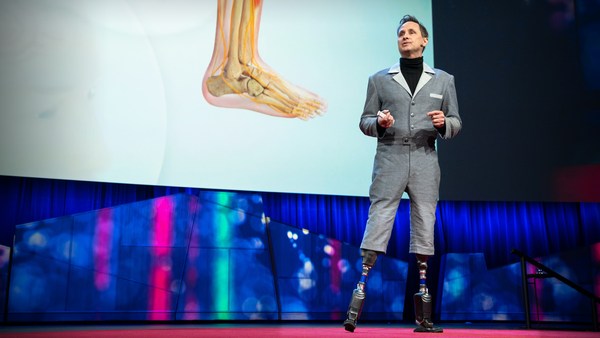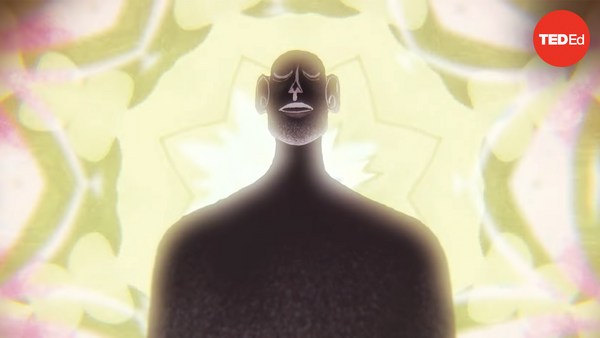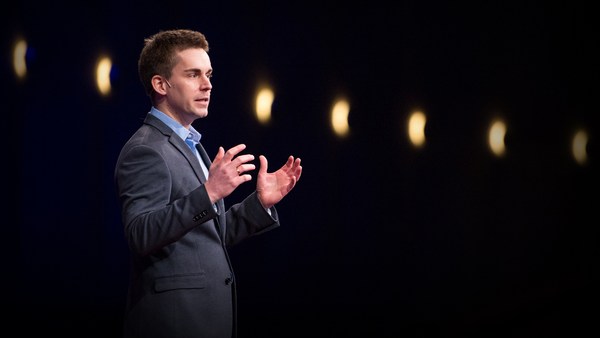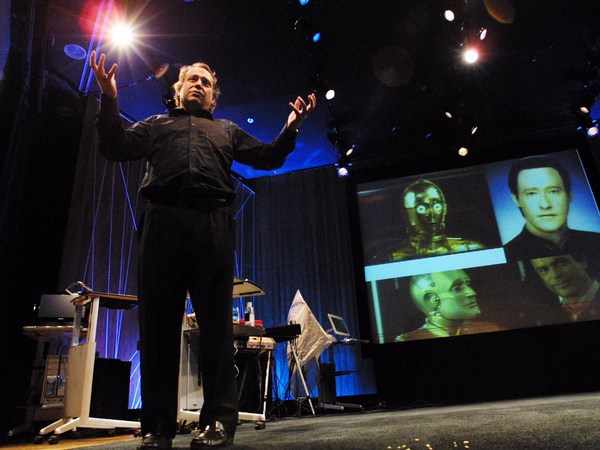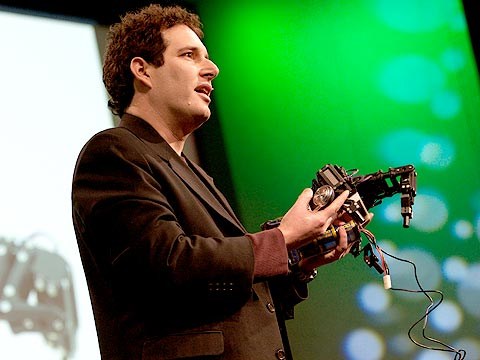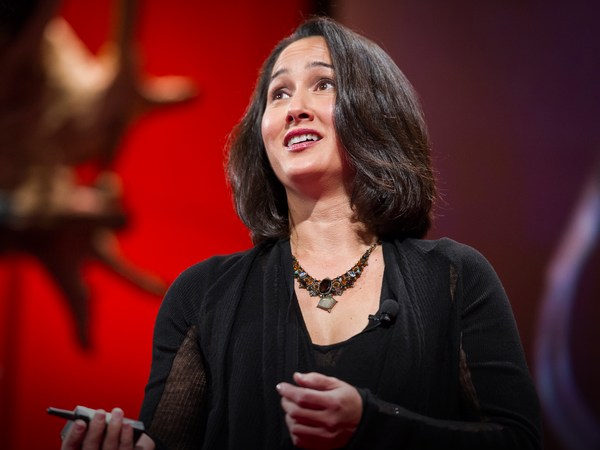Like many people who have been fortunate enough to be more or less healthy, I spent most of my life never thinking much about my body. Something that I relied on to get me around, not to mind the occasional bash and not to complain too much if I wasn't getting enough rest.
But that all changed for me when I became pregnant. Suddenly, my body was this machine performing an incredible task. That was something that I had to take notice of and look after, so that it could do its job.
I've been a documentary photographer for nearly 20 years now but I never turned the camera on myself until that time. And then suddenly, I found myself fascinated by how we feel about our bodies and how we express strength or fear, courage or shyness in the way we carry ourselves. I spent several years making work that examined the relationship that we have to our bodies as humans. More recently, though, I've been exploring a new frontier in the human body. A transformation of bodies with technology.
As humans evolve along with technology, and the lines between the two become increasingly blurred, I set out to document our evolution into a new kind of human and to play with that age-old question: Can we ever see a real humanness in machines?
Sight is perhaps the most personal and intimate of our senses. Classically called the window to the soul. We connect with each other, recognize each other and communicate with each other through our eyes. If we lose an eye, we might wear a dummy replacement so that our face resembles what it did before. Filmmaker Rob Spence took that a step further when he installed a video camera in his replacement eye so that he could record his vision. Rob is part of a known network of cyborgs and he told me that he found it curious when he started to receive hate mail from people who felt threatened by him having this extra ability. Was his right to change his body less important than their right to their privacy?
So as I photographed Rob, he filmed me using the camera in his eye, and we recorded it on a special receiver. But perhaps in response to the speed with which we all move and make images these days I wanted to make this work in a way that was slow and purposeful. Most of these images are shot on a large-format camera. These are big and cumbersome, taking only one frame at a time before you have to change the film. To check the focus, you have to put your head under a black cloth and use a magnifying glass. So as I photographed Rob using this very old technology, he filmed me using the camera in his eye, somewhat the opposite end of the technology spectrum.
But I wanted to delve deeper and explore more of what it could mean to lose a part of ourselves and replace it with technology. At MIT Media Lab they are doing some of the most cutting-edge work in biomechatronics, developing motorized limbs for amputees. Originally set up by Hugh Herr, a double amputee who was able to develop and test the equipment on himself. He went on to create a set of legs that can walk, run and even jump without seeming to be mechanical at all. The gait more closely resembles that of a human foot and leg because the motor gives the wearer a push off the floor to move the foot forwards from the ankle.
The technology here, continuing to be developed by Matt Carney and his colleagues at MIT, is really quite impressive, with the prosthesis connecting directly into the amputee's bone for stability, and sensors reading pulses from the amputee's muscles to tell the limb how to move. Ultimately, the wearer should be able to think about moving their foot and the foot would move. They're impressive to look at by themselves. But of course, the prostheses don't move on their own.
In order to show their relationship to humans, I wanted to show how they enable amputees to move with ease and fluidity. But how do you photograph gait? At this point, I was inspired by the work and photographs of Eadweard Muybridge, who is famous for his series of images of a running horse, made in 1878, to prove that there's a moment when all four of the horse's feet are off the ground at the same time. He went on to make hundreds of series of images of animals and humans in motion. It was groundbreaking work and gave us one of the first opportunities to study the anatomy of motion. So I wanted to try and create similar kinds of motion studies of amputees walking, running, jumping, using this technology, and to think of them as motion studies of an enhanced human motion.
One of the things I learned at MIT was the incredible importance of balance and the complex system of reactions and muscles that enable us to stand on two feet. Those of us with children will remember with fond nostalgia the moment our kids take their first steps. But what we think of as endearing is actually an incredible feat of balance and counterbalance. It can be quite daunting. This is my daughter Lorelei standing for the first time without any support. It lasted only a few seconds.
Dance, in particular, is all about balance and mastering the fluidity of movement. Pollyanna here lost her leg in an accident when she was just two years old. She's learned to dance with the aid of a blade prosthesis and she now competes in a class alongside nonamputees. But the skill of moving around on two legs and navigating often uneven ground is incredibly difficult to replicate.
Over at Munich's technical university they've developed LOLA, a biped humanoid robot that can move on two legs and make her way around a series of obstacles. As she strides along, she looks powerful and impressive. But her movement is also somewhat clunky and mechanical and not as spontaneous or unpredictable as that of humans. At the end of it all, when she switched off, she hung down on her cables and looked kind of forlorn. And in that moment, I saw her as more human than I had done when she was walking along. I felt almost sorry that she had been switched off. Her exterior might be cold and mechanical, but when vulnerable, she looked more real to me.
Alex Lewis is a quadruple amputee who lost his limbs and part of his face when he fell ill with strep A. One of the most inspiring people I have ever met. His journey to recovery has been an incredibly tough one. He now has a chip in his arm to open his front door, a set of mechanical arms, and a handcycle to get around. Depending on what he is doing, be it throwing a ball for the dog, riding his handcycle, or even canoeing, he has a different set of hands that he attach to the end of his arms.
It's been a very tough journey, but the hardships he's faced have given Alex a superhuman ambition. He genuinely told me that his ordeal is the best thing that ever happened to him. He now goes on expeditions, climbing mountains in Africa, he's planning to cycle across Mongolia, and he works with London’s Imperial College, helping to develop a motorized hand, much like the legs they are developing at MIT. He may be less physically able than before, but understanding his weaknesses has made Alex emotionally very strong and opened up a world of opportunity for him. It made me realize that our emotions and understanding the limits of our physicality are also a huge part of what makes us strong.
In Osaka I meet professor Ishiguro, who makes robots with uncannily human faces and expressions. First, I meet Geminoid, the robot he created in his own likeness. On the grid here you can see three pictures of the robot, one of the professor. Can you tell which is which?
One of his more recent creations is Ibuki, a robot made to look like a ten-year-old boy, who can wave and show a range of facial expressions. In those expressions, I saw a certain vulnerability that made Ibuki feel very real to me. When he was angry or sad, it resonated. And when he smiled, I wanted to smile back. I feel I was drawn to Ibuki as I might have been to a real child. And at the end of it all, I felt I wanted to thank him or reach out and shake his hand. So if understanding the limits of our physicality can help to make us stronger, then seeing the vulnerability in Ibuki's expressions made him feel more human to me.
So where do we go from here? In Tokyo, I meet professor Takeuchi who's developed a form of synthetic muscle that can respond to an electric pulse and expand or contract just like a real muscle. As it does so, the little limb here moves back and forth. Now this sample is only tiny, but imagine the possibilities if synthetic limbs could be made out of this. And what if that could be combined with the technology that reads nerve pulses from the end of an amputee's limb? Perhaps it could respond to touch and feel something hot or sharp, sending a message back up to our brains, just like it does in our body. Understanding those vulnerabilities would make the technology stronger too.
Throughout the course of making this work, I've met some incredible people, both using and creating technology. I've seen crazy possibilities for how we'll mend and enhance our bodies. But I've also smiled at a robot, seen a young girl leap through the air on a blade and shaken the hand of a man with no hands who towers emotionally above us all. I'm left in awe of the complexity of the human body.
But I also feel that it's not just our bodies, bionics or not, that make us strong, but our emotions and understanding our weaknesses. But I'd like to think of these works as studies, something that we can come back to and carefully observe. A point in our evolution before time runs away with us all.
Thank you.
